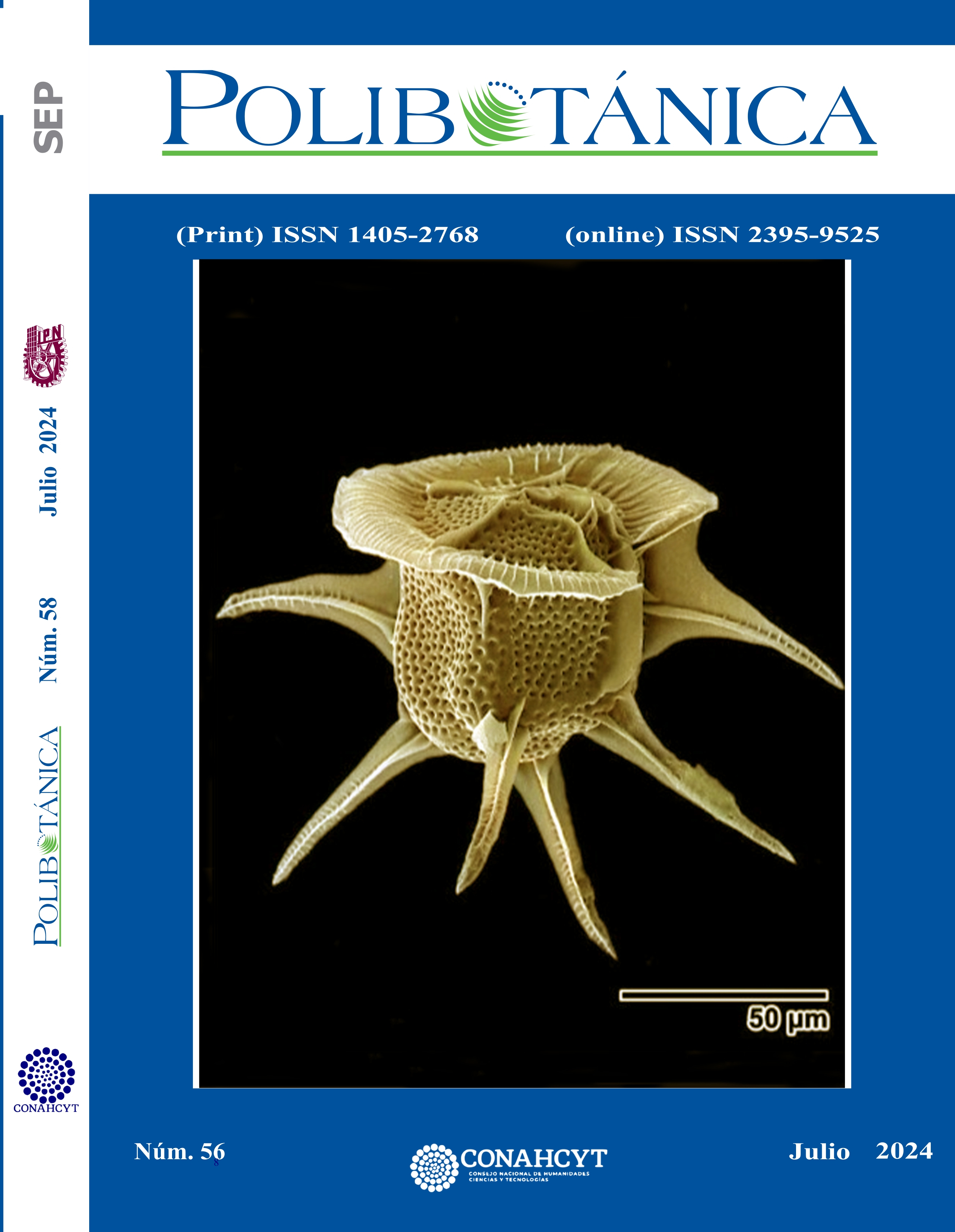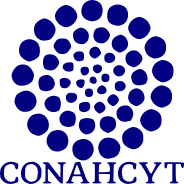Behavior of native tomatoes(Solanum lycopersicum L.) from Southeastern Mexico to Bemisia tabaci-Begomovirus complex
DOI:
https://doi.org/10.18387/polibotanica.58.16Keywords:
Bemisia tabaci, Solanum lycopersicum, viruses, ovipositionAbstract
The whitefly Bemisia tabaci Genn. is a plant pest highly harmful to horticultural crops worldwide. A sustainable strategy for the management of this pest is the search for plant resistance. Wild tomatoes are a crucial source of genetic diversity and genes for resistance to biotic factors as pest incidence. This study was conducted to assess the attraction and oviposition of B. tabaci of 15 accessions of creole tomatoes in greenhouse and to evaluate the incidence and severity of begomovirus in a field trial. The bioassay of adult attraction and preference oviposition of B. tabaci in the greenhouse showed that the Rosa pa’ak ez2 accession had the lowest number of adults (0.7 per cm2) and Socato uptl had the lowest preference for oviposition (0.8 eggs per cm2). In the field, the País ac and Rosa pa’ak ez2 accessions had significantly fewer adults on the foliage. For the incidence and severity symptoms, Socato uptl had 76.7% of plants with virus symptoms and severity of 2.2 (60 days after transplant) and 2.9 (75 days after transplant), respectively. These results contribute to the search for sustainable alternatives for vector and virus management in tomato crops.
References
Anaya-López, J.L., Torres-Pacheco, I., González-Chavira, M., Garzón-Tiznado, J.A. & Pons-Hernández, J.L. (2003). Resistance to Geminivirus mixed infection in Mexican wild peppers. Horticulture Science, 38, 251-255. https://doi.org/10.21273/HORTSCI.38.2.251
Andres, M. R., & Connors, E. F. (2003). The community-wide and guild-specific effects of pubescence on the folivorous insects of manzanitas Arctostaphylos spp. Ecological Entomology, 28, 383–396. https://doi.org/10.1046/j.1365-2311.2003.00532.x
Bai, Y., & Lindhout, P. (2007). Domestication and breeding of tomatoes: what have we gained and what can we gain in the future? Annals of Botany, 100, 1085-1094. https://doi.org/10.1093/aob/mcm150
Belay, D.K., Huckaba, R.M., Ramirez, A. M., Rodrigues, J. C. V., & Foster, J. E. (2012). Insecticidal control of Bemisia tabaci (Hemiptera: Aleyrodidae) transmitting Carlavirus on soybeans and detection of the virus in alternate hosts. Crop Protection, 35, 53–57. https://doi.org/10.1016/j.cropro.2011.12.020
Bergougnoux, V. (2014). The history of tomato: from domestication to biopharming. Biotechnology Advances, 32, 170-189. https://doi.org/10.1016/j.biotechadv.2013.11.003
Bieberach, F. C., Zanya, A. R., & Rita, G. H. (2013). Genes de resistencia a Begomovirus en germoplasma de tomate (Solanum lycopersicum L.) Colectado en panamá. Ciencia Agropecuaria, 21, 104 - 118.
Caballero, R., Schuster, D. J., Peres, N. A., Mangandi, J., Hasing, T., Trexler, F., Kalb, S., Portillo, H. E., Marc, P. C., & Annan, B. (2015). Effectiveness of cyantraniliprole for managing Bemisia tabaci (Hempitera: Aleyrodidae) and interfering with transmission of tomato yellow leaf curl virus on tomato. Journal of Economic Entomology, 108, 894-903. https://doi.org/10.1093/jee/tou034
Chermenskaya, T. D., Petrova, M. O., & Savelieva, E. I. (2009). Laboratory and field evaluation of biological active substances of plant origin against greenhouse whitefly, Trialeurodes vaporariorum Westw (Homoptera: Aleyrodidae). Archives of Phytopathology Plant Protection, 42, 864–873. https://doi.org/10.1080/03235400701494422
Chu, C. C., Henneberry, T. J., & Cohen, A. (1995). Bemisia argentifolii (Homoptera: Aleyrodidae): host preference and factors affecting oviposition and feeding site preference. Environmental Entomology, 24, 354–360. https://doi.org/10.1093/EE/24.2.354
Fancelli, M., Vendramim, J. D., Lourenção, A. L. & Días, C. T.S. (2003). Atratividade e Preferência Para Oviposição de Bemisia tabaci (Gennadius) (Hemiptera: Aleyrodidae) Biótipo B em Genótipos de Tomateiro. Neotropical Entomology, 32, 319-328. https://doi.org/10.1590/S1519-566X2003000200019
Fancelli, M., Vendramim, J.D., Frighetto, R. T.S., & Lourencao, A. L. (2005). Glandular exudate of tomato genotypes and development of Bemisia tabaci (Genn.) (Sternorrhyncha: Aleyrodidae) biotype B. Neotropical Entomology, 34, 659-665. http://dx.doi.org/10.1590/S1519-566X2005000400017
Firdaus, S., van Heusden, A.W., Hidayati, N., Supena, E. D. J., Visser, R. G. F., & Vosman, B. (2012). Resistance to Bemisia tabaci in tomato wild relatives. Euphytica, 187, 31–45. http://doi.org/10.1007/s10681-012-0704-2
Foolad, M. R. (2007). Genome mapping and molecular breeding of tomato. International Journal of Plant Genomics, 52. http://doi.org/10.1155/2007/64358
García-Martínez, S., Andreani, L., Garcia-Gusano, M., Geuna, F., & Ruiz, J. J. (2006). Evaluation of amplified fragment length polymorphism and simple sequence repeats for tomato germplasm fingerprinting: utility for grouping closely related traditional cultivars. Genome, 49, 648-656. http://doi.org/10.1139/g06-016.
Garzón-Tiznado J. A., Lugo-Lujan J. M., Hernández-Verdugo S., Medina-López R., Velarde-Félix S., Portillo-Loera J. J., Retes-Manjarrez J. E. (2020). Antixenosis a Bemisia tabaci1 Mediterranean en poblaciones criollas y silvestres de tomate de México. Southwestern Entomologist, 45, 501–510. https://doi.org/10.3958/059.045.0218
Giordano, L. B., Fonseca, M. E. N., Silva, J. B. C., Inoue-Nagata, A. K., & Boiteux, L. S. (2005). Efeito da infeccao precoce de Begomovırus com genoma bipartido em características de fruto de tomate industrial. Horticultura Brasileira, 23, 815–818. https://doi.org/10.1590/S0102-05362005000300025
Hernández-Alvarado, L. A., Ruiz-Sánchez, E., Latournerie-Moreno, L., Garruña-Hernández, R., González-Mendoza, D., & Chan-Cupul, W. (2019). Resistance of Capsicum annuum genotypes to Bemisia tabaci and influence of plant leaf traits. Revista Fitotecnia Mexicana, 42, 251 – 257. https://doi.org/10.35196/rfm.2019.3.251-257
Hernández-Espinal, L. A., Enríquez-Verdugo, I., Melgoza-Villagómez, C. M., Retes-Manjarrez, J. E., Velarde-Félix, S., Linares-Flores, P. J., & Garzón-Tiznado, J. A. (2018). Análisis filogenético y distribución de begomovirus en el cultivo del chile (Capsicum annuum L.) en Sinaloa, México. Revista Fitotecnia Mexicana, 41, 49-157. https://doi.org/10.35196/RFM.2018.2.149-157
Kontsedalov, S., Gottlieb, Y., Ishaaya, I., Nauen, R., Horowitz, R., & Ghanim, M. (2009). Toxicity of spiromesifen to the developmental stages of Bemisia tabaci biotype B. Pest Management Science, 65, 5–13. https://doi.org/10.1002/ps.1636.
Leckie, B. M., D’Ambrosio, D. A., Chappell, T. M., Halitschke, R., De Jong, D. M., Kessler, A., Kennedy, G. G., & Mutschler, M. A. (2016). Differential and Synergistic Functionality of Acylsugars in Suppressing Oviposition by Insect Herbivores. PLoS ONE, 11, e0153345. https://doi.org/10.1371/journal.pone.0153345
Li, Y., Mbata, G.N., Punnuri, S.; Simmons, A.M., Shapiro-Ilan, D.I. (2021). Bemisia tabaci on vegetables in the Southern United States: incidence, impact, and management. Insects, 12, 198. https://doi.org/10.3390/ insects12030198
Lucini, T., Faria, M. V., Rohde, C., Resende, J. T. V. & Oliveira, J. R. F. (2015). Acylsugar and the role of trichomes in tomato genotypes resistance to Tetranychus urticae. Arthropod-Plant Interactions, 9, 45-53. https://doi.org/10.1007/s11829-014-9347-7
Mansaray, A., & Sundufu, A.J. (2009). Oviposition, development and survivorship of the sweetpotato whitefly Bemisia tabaci on soybean, Glycine max, and the garden bean, Phaseolus vulgaris. Journal of Insect Science, 9, 107. https://doi.org/10.1673/031.009.0101
Millán-Chaidez, R., Garzón-Tiznada, J.A., Linares-Flores, P.J., Velarde-Félix, S., Lugo-García, G.A. & Retes-Manjarrez, J.E. (2020). Resistance to Bemisia tabaci (Hemiptera: Aleyrodidae) mediterranean (Q biotype) in landrace and wild tomate populations from Mexico. Florida Entomologist, 103, 472-478. https://doi.org/10.1653/024.103.00409
Miller, J. C., & Tanksley, S. D. (1990). RFLP analysis of phylogenetic relationships and genetic variation in the genus Lycopersicon. Theoretical and Applied Genetics, 80, 437-448. https://doi.org/10.1007/BF00226743
Oliveira, M. R. V., Henneberry, T. J., & Anderson, P. (2001). History, current status, and collaborative research projects for Bemisia tabaci. Crop Protection, 20, 709–723. https://doi.org/10.1016/S0261-2194(01)00108-9
Oriani, M. A. G., Vendramim, J. D., & Vasconcelos, C. J. (2011). Biology of Bemisia tabaci (Genn.) B biotype (Hemiptera, Aleyrodidae) on tomato genotypes. Scientia Agricola, 68, 37-41. https://doi.org/10.1590/S0103-90162011000100006
Peralta, I. E. & Spooner, A. M. (2007). History, origin and early cultivation of tomato (Solanaceae). In: Genetic Improvement of Solanaceous Crops, Vol. 2: Tomato. M. K. Razdan and A. K. Mattoo (eds.). Science Publishers. Enfield, New Hampshire, USA. pp.1- 24
Pérez-Verdugo, O. C., Ruiz-Sánchez, E., Gamboa-Angulo, M., Latournerie-Moreno, L., Fernández-Concha, G. C., Cua-Basulto, M. & Chan-Cupul, W. (2019). Actividad biológica de productos derivados de plantas en mosquita blanca (Bemisia tabaci) y su parasitoide Encarsia formosa. Tropical and Subtropical Agroecosystems, 22, 575-583.
Rakha, M., Hanson, P., & Ramasamy, S. (2017). Identification of resistance to Bemisia tabaci Genn. in closely related wild relatives of cultivated tomato based on trichome type analysis and choice and no-choice assays. Genetic Resources and Crop Evolution, 64, 247–260. http://doi.org/10.1007/s10722-015-0347-y
Rojas, A., Kvarnheden, A. & Valkonen, J. P. T. (2000). Geminiviruses infecting tomato crops in Nicaragua. Plant Disease, 84, 843-846. https://doi.org/10.1094/PDIS.2000.84.8.843
Sánchez-Peña P., Oyama K., Núñez-Farfán J., Fornoni J., Hernández-Verdugo S., Márquez-Guzmán J., Garzón-Tiznado J. A. (2006). Sources of Resistance to Whitefly (Bemisia spp.) in Wild Populations of Solanum lycopersicum var. Cerasiforme (Dunal) Spooner G.J. Anderson et R.K. Jansen in Northwestern Mexico. Genetic Resources and Crop Evolution, 53(4): 711–719. https://doi.org/10.1007/s10722-004-3943-9
Silva, K. F.A.S., Michereff-Filho, M., Fonseca, M. E. N., Silva-Filho J. G., Texeira, A. C.A., Moita, A. W., Torres, J. B., Fernández-Muñoz, R. & Boiteux, L. S. (2014). Resistance to Bemisia tabaci biotype B of Solanum pimpinellifolium is associated with higher densities of type IV glandular trichomes and acylsugar accumulation. Entomologia Experimentalis et Applicata, 151, 218–230. https://doi.org/10.1111/eea.12189
Simmons, A. & Gurr, G. (2005). Trichomes of Lycopersicon species and their hybrids: effects on pests and natural enemies. Agricultural and Forest Entomology, 7, 265-276. https://doi.org/10.1111/j.1461-9555.2005.00271.x
Toscano, L., Boiça, J, A., Maia, J. & Almeida, J. (2001). Tipos de tricomas em genotipos de Lycopersicon. Horticultura Brasileira, 19(3): 204-206. https://doi.org/10.1590/S0102-05362001000300009
Van Lenteren, J. C. & Noldus, L. P. J. (1990). Whiteflies plant relationships: Behavioural and ecological aspects. In: Gerling D, editor. Whiteflies: Their bionomics, pest status and management. Intercept Ltd; pp. 227–261.
Downloads
Published
Issue
Section
License

Polibotánica by Departamento de Botánica de la Escuela Nacional de Ciencias Biológicas del Instituto Politécnico Nacional se distribuye bajo una Licencia Creative Commons Atribución-NoComercial-CompartirIgual 4.0 Internacional.




















